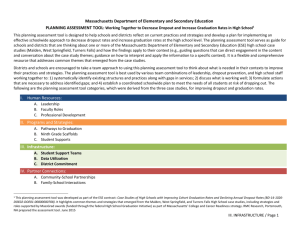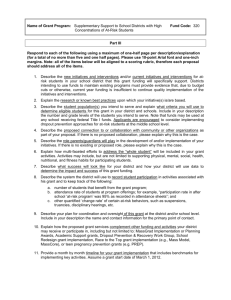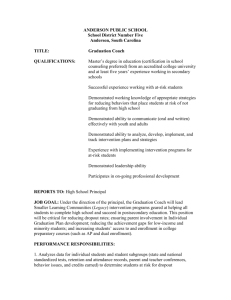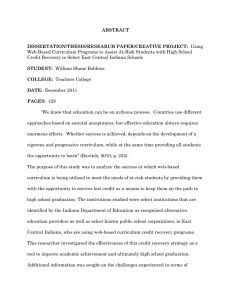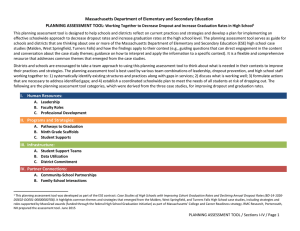2015 MA HSCaseStudyTool I
advertisement
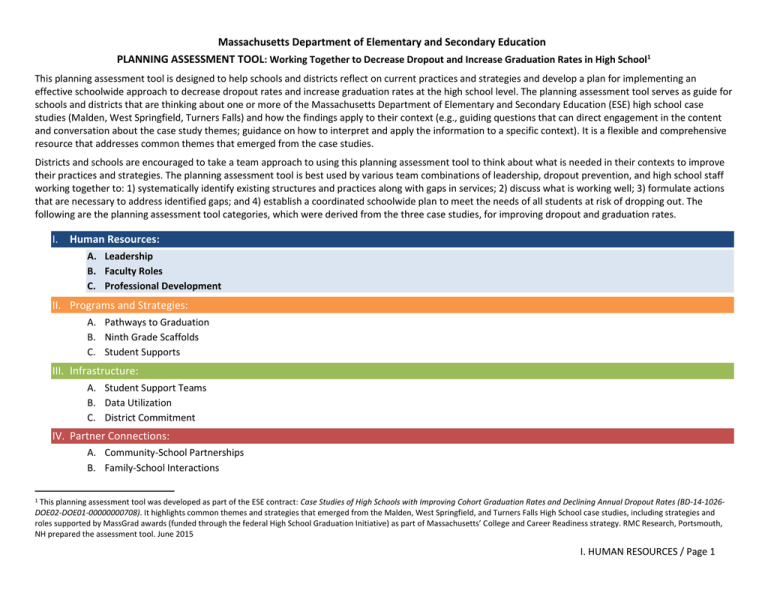
Massachusetts Department of Elementary and Secondary Education PLANNING ASSESSMENT TOOL: Working Together to Decrease Dropout and Increase Graduation Rates in High School1 This planning assessment tool is designed to help schools and districts reflect on current practices and strategies and develop a plan for implementing an effective schoolwide approach to decrease dropout rates and increase graduation rates at the high school level. The planning assessment tool serves as guide for schools and districts that are thinking about one or more of the Massachusetts Department of Elementary and Secondary Education (ESE) high school case studies (Malden, West Springfield, Turners Falls) and how the findings apply to their context (e.g., guiding questions that can direct engagement in the content and conversation about the case study themes; guidance on how to interpret and apply the information to a specific context). It is a flexible and comprehensive resource that addresses common themes that emerged from the case studies. Districts and schools are encouraged to take a team approach to using this planning assessment tool to think about what is needed in their contexts to improve their practices and strategies. The planning assessment tool is best used by various team combinations of leadership, dropout prevention, and high school staff working together to: 1) systematically identify existing structures and practices along with gaps in services; 2) discuss what is working well; 3) formulate actions that are necessary to address identified gaps; and 4) establish a coordinated schoolwide plan to meet the needs of all students at risk of dropping out. The following are the planning assessment tool categories, which were derived from the three case studies, for improving dropout and graduation rates. I. Human Resources: A. Leadership B. Faculty Roles C. Professional Development II. Programs and Strategies: A. Pathways to Graduation B. Ninth Grade Scaffolds C. Student Supports III. Infrastructure: A. Student Support Teams B. Data Utilization C. District Commitment IV. Partner Connections: A. Community-School Partnerships B. Family-School Interactions 1 This planning assessment tool was developed as part of the ESE contract: Case Studies of High Schools with Improving Cohort Graduation Rates and Declining Annual Dropout Rates (BD-14-1026DOE02-DOE01-00000000708). It highlights common themes and strategies that emerged from the Malden, West Springfield, and Turners Falls High School case studies, including strategies and roles supported by MassGrad awards (funded through the federal High School Graduation Initiative) as part of Massachusetts’ College and Career Readiness strategy. RMC Research, Portsmouth, NH prepared the assessment tool. June 2015 I. HUMAN RESOURCES / Page 1 RATE CURRENT STATUS SCHOOL STRUCTURES, PRACTICES, STRATEGIES Fully in Place Partially in Place Not Yet in Place DISCUSSION NOTES (WHAT’S IN PLACE?) I. HUMAN RESOURCES A. LEADERSHIP 1. The school principal has built a leadership team that has regular opportunities to deliberate the progress of at-risk students. 2. Programs that function as schools-withinschools, e.g., alternative schools and academies, have designated leaders who are on the school’s administrative team. 3. Leaders organize opportunities for teams to meet regularly to exchange information, evaluate progress, and make continuous improvements. Examples include outreach teams, data teams, and student referral/ support teams. 4. High school leaders have worked with middle school leaders to create transition activities to prepare middle school students for adjustment to the ninth grade. 5. School leaders support options beyond the regular course structure for struggling students to learn and attain academic credits, e.g., credit recovery courses, summer options. 6. The school principal sets a vision for educating ALL students that includes a rationale for focusing on reducing dropouts and increasing graduation rates. 7. School leaders set high expectations for the academic achievement of ALL students by maintaining rigor across pathways and programs. 8. Leadership sets challenging targets for dropout and graduation rates and reviews I. HUMAN RESOURCES / A. Leadership / Page 2 RATE CURRENT STATUS SCHOOL STRUCTURES, PRACTICES, STRATEGIES Fully in Place Partially in Place Not Yet in Place DISCUSSION NOTES (WHAT’S IN PLACE?) I. HUMAN RESOURCES A. LEADERSHIP progress against those targets. 9. The school principal sets high standards for all students and encourages faculty discussion of promoting academic rigor while supporting at-risk students. 10. District and school leaders encourage staff to use data (e.g., EWIS in Edwin Analytics) to identify at-risk students and set expectations for achievement. 11. Leaders recognize the importance of professional development for faculty and create opportunities for PLCs and other types of professional development. Leaders are actively involved in professional development. 12. Within the educator evaluation structure employed by the school, leaders have emphasized staff roles in creating a climate where struggling students can receive support. 13. School leaders have developed partnerships with leaders from the community and community service providers for the purpose of providing support services to at-risk students and their families. I. HUMAN RESOURCES / A. Leadership / Page 3 PLANS FOR NEXT STEPS I. HUMAN RESOURCES / A. LEADERSHIP 1. Review the discussion notes and identify common themes – Are there underlying needs (e.g., additional guidance staff) or common desired strategies (e.g., professional development in working with struggling students)? 2. Note the themes below and discuss priorities – Which approaches can be accomplished without additional resources and which require a longer-term strategy of reallocating resources? 3. Use that information to determine next steps – Consider a multi-prong strategy that will bring about some “quick wins” while you are working toward longer-term changes. I. HUMAN RESOURCES / A. Leadership / Page 4 RATE CURRENT STATUS SCHOOL STRUCTURES, PRACTICES, STRATEGIES Fully in Place Partially in Place Not Yet in Place DISCUSSION NOTES (WHAT’S IN PLACE?) I. HUMAN RESOURCES B. FACULTY ROLES 1. The school has adjustment counselors who address the behavioral/emotional needs of students so they can focus on academics. 2. The school has one or more staff members with a social work background who are able to address the range of needs of at-risk students from a holistic perspective. 3. The school has a formal program of mentoring, matching adults in the school and community with at-risk students to provide additional positive role models in students’ lives. 4. At least some staff have the ongoing role of making connections with students’ families and the community. 5. Some academic staff teach courses during the summer to support credit recovery and key academic transitions, especially from middle school to high school or from ninth to tenth grade. 6. Academic department chairpersons take on the role of supporting faculty members to work with students who are struggling, including coaching, developing learning plans, student placement, and/or assisting with diagnostic assessments. 7. Some members of academic departments take on the role of supporting and monitoring online credit recovery coursework, providing students with access to a highly qualified teacher in their subject I. HUMAN RESOURCES / B. Faculty Roles / Page 5 RATE CURRENT STATUS SCHOOL STRUCTURES, PRACTICES, STRATEGIES Fully in Place Partially in Place Not Yet in Place DISCUSSION NOTES (WHAT’S IN PLACE?) I. HUMAN RESOURCES B. FACULTY ROLES area. 8. All faculty are expected to build positive relationships with students to ensure that students feel well connected to the school. 9. Faculty who are directly involved in dropout prevention programs work collaboratively with their community counterparts (e.g., community youth resources). 10. Teaching faculty who are working in alternative programs also are considered members of the school’s academic departments (e.g., English language arts, science, history, mathematics) and participate in regular department meetings. 11. Guidance and other staff have explicit roles for easing the transition between middle and high school. 12. One or more staff members who focus on at-risk students have flexible schedules so that they are available during the school day to address immediately the concerns of specific students. The school has identified a welcoming and “safe” location (e.g., drop-in center, alternative learning center) where students can meet with designated staff during the school day, as needed. 13. The high school supports at least one graduation coach whose main focus is to reduce the dropout rate and help students move toward graduation. 14. The graduation coach conducts exit I. HUMAN RESOURCES / B. Faculty Roles / Page 6 RATE CURRENT STATUS SCHOOL STRUCTURES, PRACTICES, STRATEGIES Fully in Place Partially in Place Not Yet in Place DISCUSSION NOTES (WHAT’S IN PLACE?) I. HUMAN RESOURCES B. FACULTY ROLES interviews of students who have dropped out and reaches out to students who previously dropped out of school to encourage them and help develop a plan for return to the school. 15. Faculty or counseling staff are designated to work with students on the development of a four-year individualized plan for graduation (i.e., Individual Learning Plans/ILPs). 16. Faculty and other staff make home visits. I. HUMAN RESOURCES / B. Faculty Roles / Page 7 PLANS FOR NEXT STEPS I. HUMAN RESOURCES / B. FACULTY ROLES 1. Review the discussion notes and identify common themes – Are there underlying needs (e.g., additional guidance staff) or common desired strategies (e.g., professional development in working with struggling students)? 2. Note the themes below and discuss priorities – Which approaches can be accomplished without additional resources and which require a longer-term strategy of reallocating resources? 3. Use that information to determine next steps – Consider a multi-prong strategy that will bring about some “quick wins” while you are working toward longer-term changes. I. HUMAN RESOURCES / B. Faculty Roles / Page 8 RATE CURRENT STATUS SCHOOL STRUCTURES, PRACTICES, STRATEGIES Fully in Place Partially in Place DISCUSSION NOTES (WHAT’S IN PLACE?) Not Yet in Place I. HUMAN RESOURCES C. PROFESSIONAL DEVELOPMENT 1. School leaders, faculty, and staff who work with students at risk of dropping out receive professional development related to dropout prevention strategies (e.g., differentiated instruction, assessment, adolescent development, and helping students who have experienced trauma and face multiple obstacles such as depression and alcohol and drug abuse). 2. Counselors provide professional development for staff to help them understand students’ circumstances outside the school and learn to provide constructive responses to students’ negative classroom behaviors. 3. To extend the dialogue on supporting youth, community members are invited to participate in those school professional development opportunities that are of mutual interest (e.g., mental health issues of at-risk students). 4. Staff teams, such as ninth grade academy or alternative school faculty and counselors, receive professional development and training together as a group. I. HUMAN RESOURCES / C. Professional Development / Page 9 RATE CURRENT STATUS SCHOOL STRUCTURES, PRACTICES, STRATEGIES Fully in Place Partially in Place DISCUSSION NOTES (WHAT’S IN PLACE?) Not Yet in Place I. HUMAN RESOURCES C. PROFESSIONAL DEVELOPMENT 5. For schools with courses focused on helping at-risk students build selfgovernance skills (e.g., Reconnecting Youth), the school provides specific training to carefully selected, dedicated staff members. 6. The principal and other school leaders provide follow up support to reinforce staff training and to model/demonstrate effective practices. 7. The school principal or guidance staff provide feedback about teachers’ implementation of strategies to support students at-risk of dropping out. 8. The school principal encourages collaboration among teaching and guidance staff for the purpose of learning about and improving dropout prevention programs and services. 9. Professional learning communities provide school teams (e.g., outreach, support, data, ninth grade academy teams) with time to plan, review practices, analyze student data, and revise teaching strategies to support students at risk for dropping out. 10. Academic department PLCs include staff members with dedicated dropout prevention and alternative school roles. 11. School provides flexibility in scheduling to support dedicated time for PLCs/team meetings. I. HUMAN RESOURCES / C. Professional Development / Page 10 RATE CURRENT STATUS SCHOOL STRUCTURES, PRACTICES, STRATEGIES Fully in Place Partially in Place DISCUSSION NOTES (WHAT’S IN PLACE?) Not Yet in Place I. HUMAN RESOURCES C. PROFESSIONAL DEVELOPMENT 12. Adjustment and guidance counselors meet and consult with teaching faculty on a regular basis, to specifically enable teachers to address both the socialemotional and academic needs of students. 13. Department chairs or other academic faculty support teachers through coaching or other types of consultation. 14. Teachers have opportunities to observe and practice effective strategies, with feedback from knowledgeable professionals, including other teachers and coaches. 15. Staff has access to professional expertise (e.g., social workers, psychologists, and other mental health providers) for consultation and referral services related to helping students at risk of dropping out. I. HUMAN RESOURCES / C. Professional Development / Page 11 PLANS FOR NEXT STEPS I. HUMAN RESOURCES / C. PROFESSIONAL DEVELOPMENT 1. Review the discussion notes and identify common themes – Are there underlying needs (e.g., additional guidance staff) or common desired strategies (e.g., professional development in working with struggling students)? 2. Note the themes below and discuss priorities – Which approaches can be accomplished without additional resources and which require a longer-term strategy of reallocating resources? 3. Use that information to determine next steps – Consider a multi-prong strategy that will bring about some “quick wins” while you are working toward longer-term changes. I. HUMAN RESOURCES / C. Professional Development / Page 12
